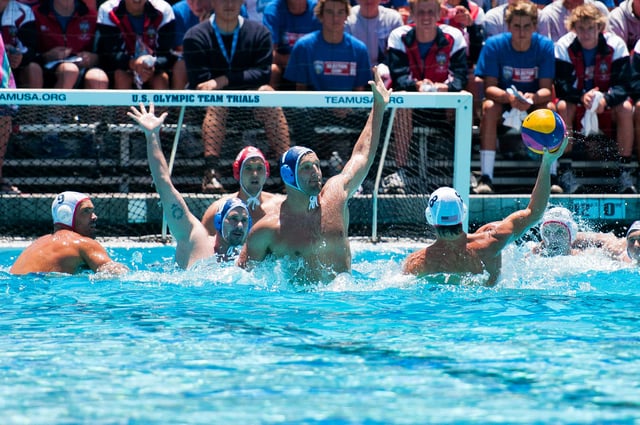5 Dryland Exercises to Improve Your Water Polo Shot
Shooting is a complex movement for all water polo players. The shot begins in the lower body and ends with an aggressive follow through with your shooting arm. Many water polo players make the mistake of training only rotational and forearm exercises. However, strengthening the entire kinetic chain of muscles is crucial for not only power production, but also for injury prevention. Any weak link in the kinetic chain can send all the force into the wrong area, compromising technique and exposing the body to acute injury. Implementing specific exercises in your dryland program will improve a player's shot.
Shooting mechanics are important for water polo players. Athletes should focus on building stability, range of motion, and power through the major muscle groups in the legs. Lower body strength and stability creates greater force production as it allows the player to set up a solid base when shooting. Additionally, by emphasizing single-leg and single-arm exercises, they balance strength and increase stability in both legs and both arms. Core exercises that focus on rotational strength are the critical piece to transferring power from the lower body to the upper body. Therefore, a strong mid-section allows players to have more control of their shot and lower the risk of injury for shoulders and upper extremities. An athlete's posterior kinetic chain is also responsible for a large portion of their force production, so strengthening the back is important. The following five dryland exercises can help athletes add balance and velocity to their shot, whether it is scoring on a fast break or from a set-piece. The dryland movements will also help athletes maintain control and shot strength throughout the game as their opponents fatigue:
1. Lying Thoracic Mobility - Squeeze
Level: All
Equipment: Anything soft to squeeze with knees.
Coach’s Tip: Thoracic rotation is very important for the water polo shot. The key here is to squeeze knees together, then press them into the ground as you rotate.
2. Slideboard Lunges - Combo
Level: Intermediate to Advanced
Equipment: Slideboard, slideboard booties
Coach’s Tip: The 3 different lunges in this combination help the water polo player with improved flexibility, stability, and strength in the legs, while stabilizing the hip capsule. These exercises are a must for all players to help set a wide, solid, and balanced foundation for the shot.
3. Slideboard Freestyle
Level: All
Equipment: Slideboard, slideboard booties
Coach’s Tip: The freestyle movement is great for shoulder and mid-section strengthening. With the amount of swimming and grappling involved in water polo, these movements help strengthen the shoulder capsule and improve “fingertips to toes connection” for swimming.
4. TRX Alligator
Level: Intermediate to Advanced
Equipment: TRX bands, suspension training bands. For novice athletes, use resistance bands instead of the TRX.
Coach’s Tip: This exercise improves shoulder mobility and stability. It helps decrease the risk of injury to the shoulder capsule prevalent from overuse from the combination of swimming, grappling and shooting.
5. Band Anti-Rotation
Level: All
Equipment: Resistance Bands
Coach’s Tip: Although the water polo shot is a very powerful, complex movement, an athlete needs to be stable and strong through the mid-section to generate power for shooting. Anti-rotational exercises aid in transferring power from the lower body and torso to the shooting arm.
Recap
Implementing these five exercises in a dryland program will significantly improve a player's shot against opponents. Discover more water polo specific dryland exercises to improve defensive skills and transition speed.
About the Author

Nick Folker is the Co-Founder and Director of Elite Performance at BridgeAthletic. Nick’s roster of athletes includes 35 Olympians winning 22 Olympic Medals, 7 team NCAA Championships and over 170 individual and relay NCAA championships.
Related Posts

The Best Bench Press Variation You’re...
This post is part of our Coaches Corner series with Taylor Rimmer. Taylor is NSCA-CPT, StrongFirst...

Does Powerlifting Harm Heart Health?
A recent study has discovered that a 12-week supervised strength training program (SSTP) may result...
-1.png)
Barefoot Running: Is It For You? |...
Run Free: Consider Less Cushion
Updated October 2020:
With more athletes looking for ways to...



